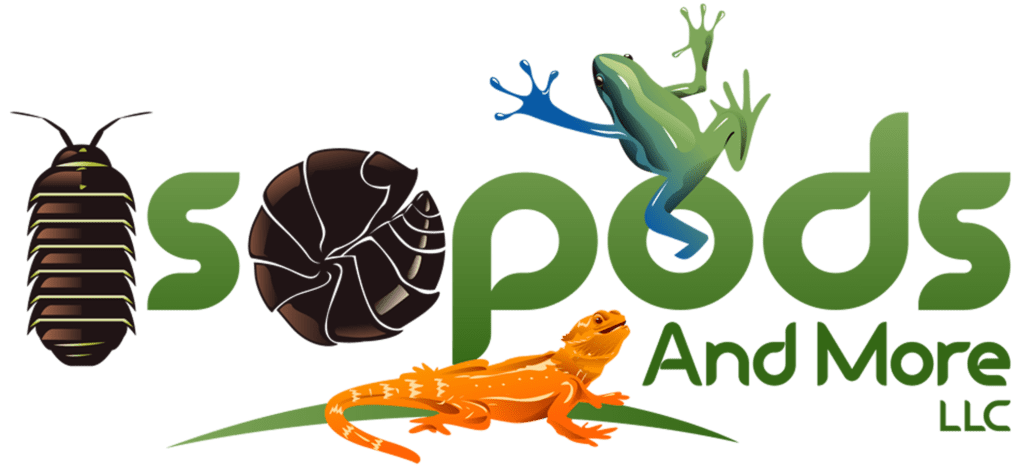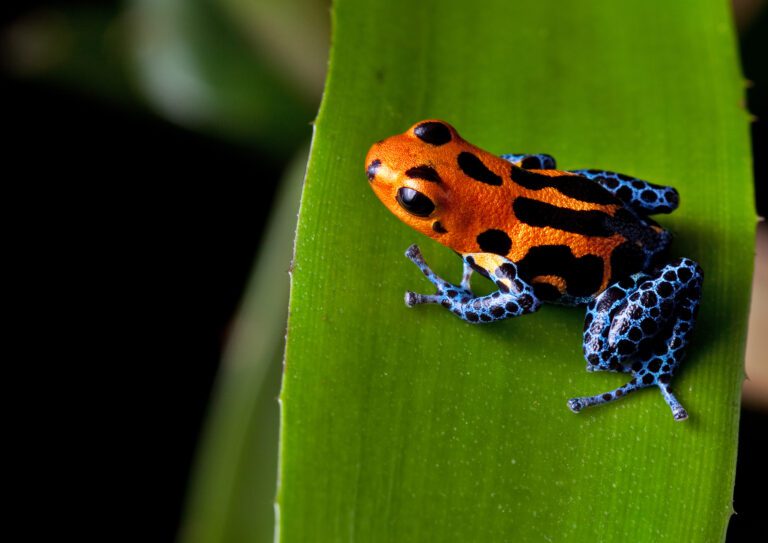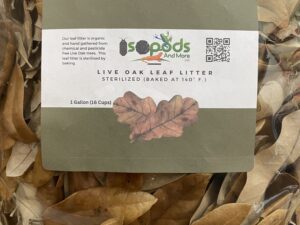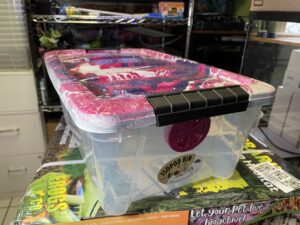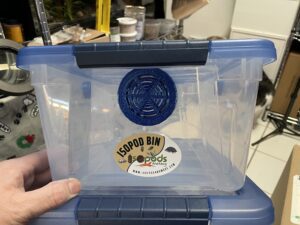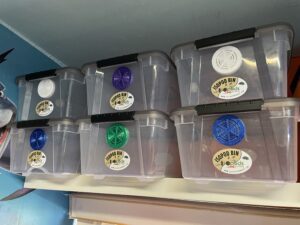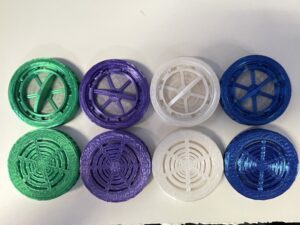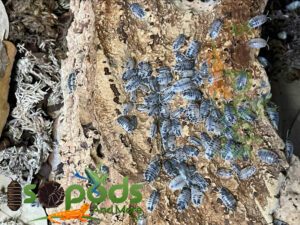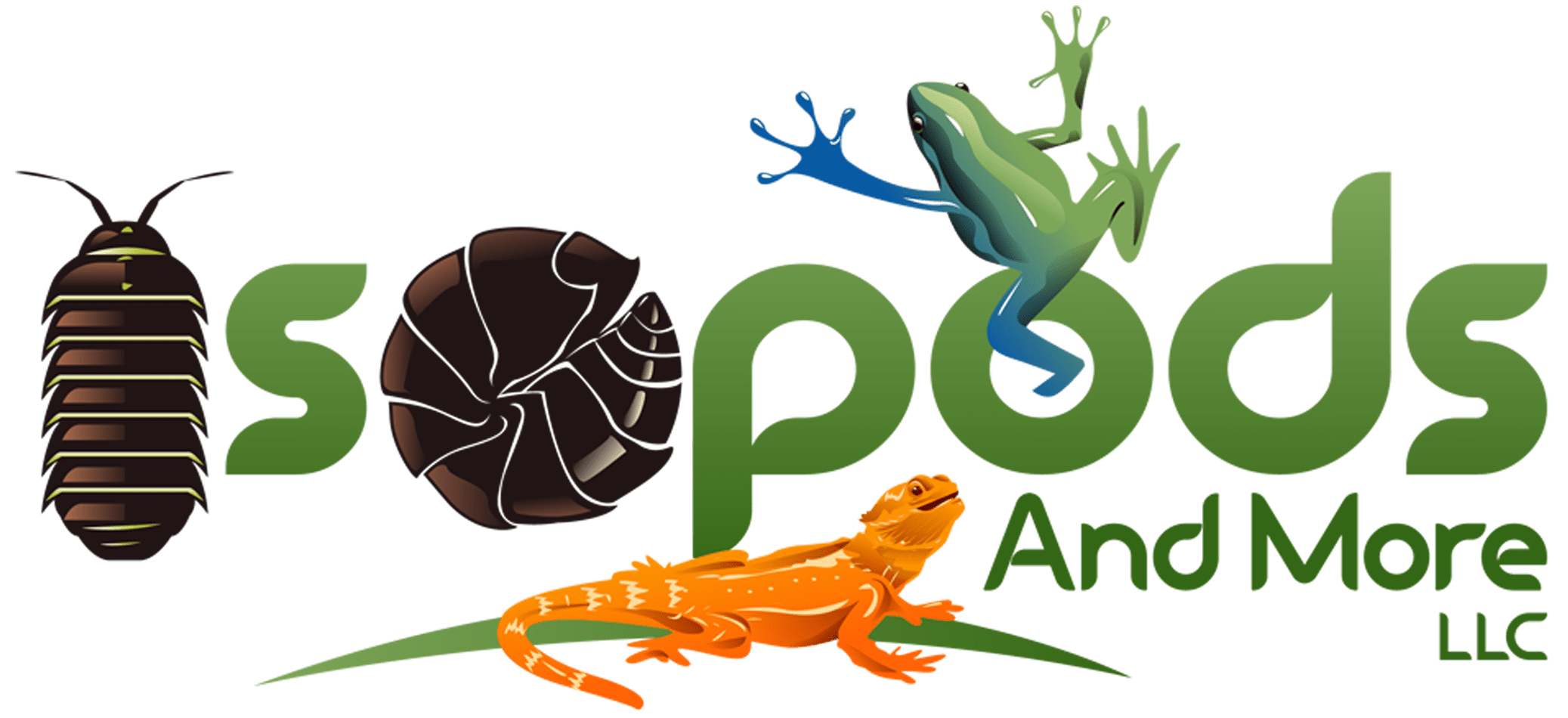Key Takeaways:
- Creating a bioactive enclosure for dart frogs offers numerous benefits, including mimicking their natural habitat and promoting their overall health and well-being.
- Choosing the right enclosure is crucial, and options such as glass tanks and commercial enclosures should be considered based on the specific needs and preferences of dart frogs.
- Key elements to focus on when designing a bioactive dart frog enclosure include proper lighting, providing water sources and maintaining humidity, heating the habitat appropriately, selecting suitable substrate, ensuring proper ventilation, and creating a rainforest-like environment through decoration.
Introduction to Bioactive Enclosures for Dart Frogs
Discover the wonders of bioactive enclosures for dart frogs and unlock the secrets to creating the ultimate habitat. Unleash the benefits of a bioactive terrarium, providing a thriving ecosystem for your dart frogs. Dive into an introduction to creating a bioactive dart frog enclosure and witness the perfect balance between nature and captivity. Get ready to embark on a journey of exploration and provide your dart frogs with the best possible living environment.
Benefits of Creating a Bioactive Terrarium
Creating a bioactive terrarium has many benefits for dart frog keeping. Such as:
- A natural and dynamic environment – more like their natural habitat – helps the frogs’ well-being and behaviour.
- Good microorganisms, like isopods and springtails, help break down waste and keep the soil healthy, avoiding harm to the frogs.
- Less frequent cleaning and lower maintenance needs due to the microorganisms.
- A beautiful, realistic representation of the rainforest.
It’s essential to carefully consider several factors like enclosure, ventilation, lighting, plants and substrate. Following these guidelines will create a captivating habitat that supports the frogs’ health and needs, while also looking great.
Bioactive terrariums also help create self-sustaining ecosystems with natural cycles, just like in their native habitat. This adds to both visual appeal and environmental balance.
In conclusion, bioactive terrariums are beneficial for both the frogs and dart frog enthusiasts. They support the frogs’ health, mimic their natural habitat and look stunning. A rewarding and enriching experience!
Introduction to Creating a Bioactive Dart Frog Enclosure
For a bioactive dart frog home, select a perfect space – be it a tank or an enclosure. Then, think about supplying the right lighting – UVA and UVB. Afterwards, create a pool and make sure the humidity is just right. Don’t forget to provide the correct temp range. Choose a substrate that has good plants and gives the frogs a place to hide. Finally, get the ventilation and air exchange in good order for the critters’ health. By doing these things, you can make a rainforest-like domain that looks amazing and meets the needs of the frogs.
Choosing the Right Enclosure
When it comes to creating the ultimate habitat for dart frogs, choosing the right enclosure is key. In this section, we’ll explore the options of glass tanks and commercial enclosures, each offering unique advantages for these bioactive environments. Discover the factors to consider and the benefits they bring, ensuring that your dart frogs thrive in their carefully curated habitat.
Glass Tanks and Commercial Enclosures
Glass tanks and commercial enclosures both have their perks for setting up a bioactive dart frog enclosure. Visibility is top-notch with glass tanks, and they provide a strong & secure home for the frogs.
Commercial enclosures come with features like ventilation systems, lighting fixtures, & access points for cleaning & feeding.
Glass tanks offer more size & layout customization, so owners can create a natural environment. Pre-installed features on commercial enclosures make it easier for beginners to set up a rainforest terrarium.
Light is a must for these frogs – they need Vitamin D to stay hoppy!
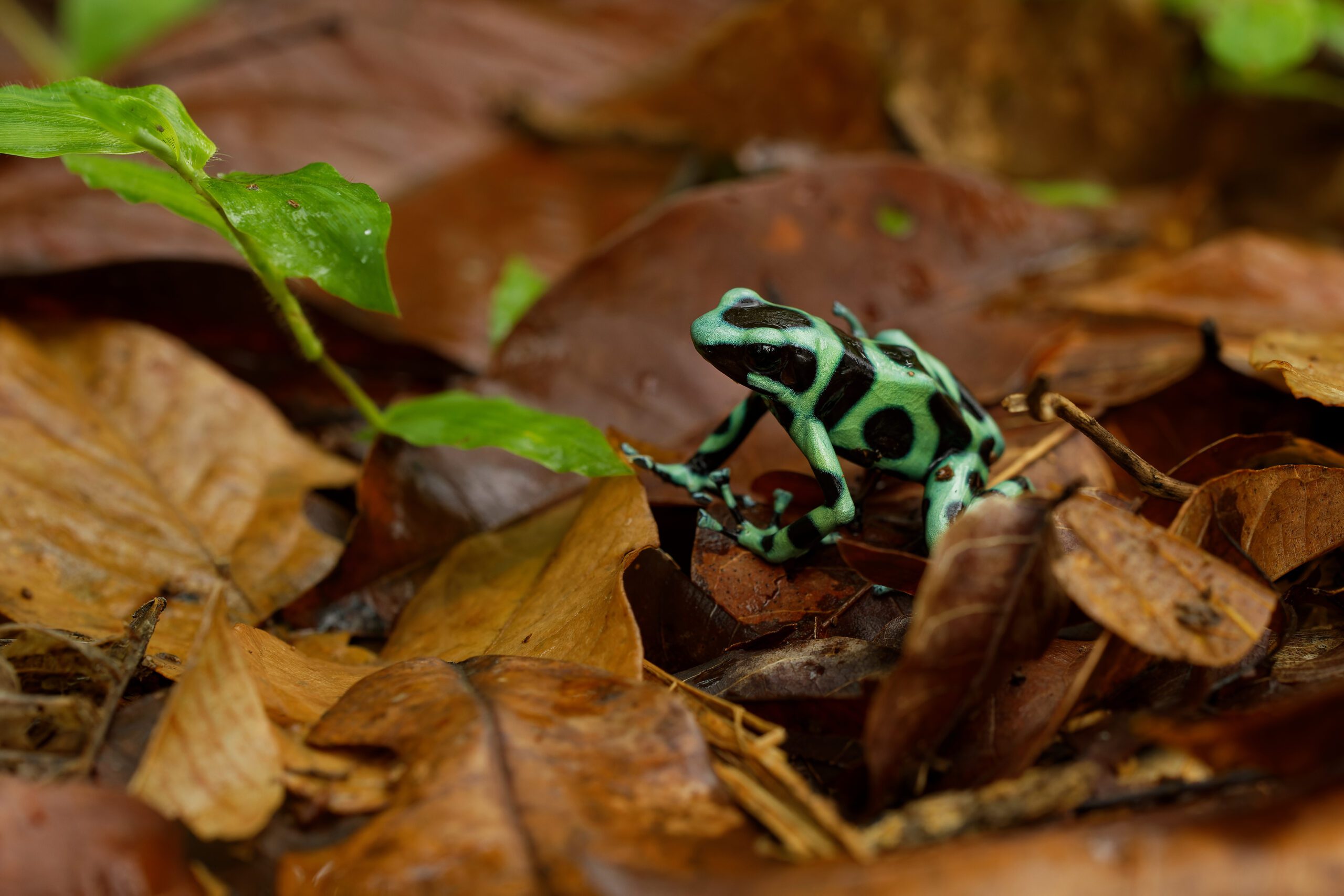
Importance of Lighting in Vivarium Design
Lighting is key when crafting the best vivarium for dart frogs. It’s not only a visually pleasing addition, but also boosts their health and wellbeing.
It’s essential to understand the lighting needs of dart frogs. To emulate their natural habitat properly, the intensity and spectrum of light must be replicated. This will help with thermoregulation, photosynthesis, and circadian rhythms.
Plus, proper lighting aids the growth of plants inside the enclosure. Frogs need live plants for shelter, breeding, and nutrition. Light helps with photosynthesis, which provides oxygen, removes carbon dioxide, and regulates humidity levels.
To ensure the right lighting, consider UVB rays. These rays are required for vitamin D3 synthesis, which absorbs calcium and keeps frogs healthy. The correct dosage must be given to avoid any deficiencies or health issues.
Lighting is essential for dart frogs in a vivarium. By replicating their natural environment, enthusiasts can create a habitat that benefits these amphibians.
Providing Water, Pools, and Maintaining Humidity
Providing Water, Pools, and Maintaining Humidity: For dart frogs in bioactive enclosures, water sources, pools, and humidity levels must be carefully monitored. This helps to recreate their natural environment and guarantee their well-being.
- Rainwater or de-chlorinated tap water can be used for hydration, making sure it’s free from contaminants.
- Creating small pools with leaf litter, moss, or containers with clean, chlorine-free water, allows the frogs to engage in natural behaviors.
- High humidity is necessary, so misting the enclosure daily, or using a humidifier is recommended. Humidity should be monitored to stay within the ideal range.
- Plants like ferns and bromeliads can help retain moisture and keep humidity levels up.
- Vents or fans should be placed to create a natural airflow, avoiding stagnant air and mold growth.
- Monitoring water sources, pools, and humidity is essential. Signs of contamination or excessive humidity should be quickly addressed.
Hence, water, pools, and humidity should be kept in check to support dart frog health and breeding in bioactive enclosures.
Heating the Habitat for Reptiles and Amphibians
Heating is key for crafting the ideal habitat for reptiles and amphibians. It is vital to give the precise temperature range to guarantee their health and wellness. The article “Unlock the Secrets of Bioactive Enclosures: Creating the Ultimate Habitat for Dart Frogs” provides great advice for achieving the best heating conditions for reptiles and amphibians.
Step 1: Comprehending the Temperature Needs
Reptiles and amphibians are ectothermic, meaning they depend on outside conditions to adjust their body temperature. It is critical to learn and comprehend the particular temperature needs of the species being housed. Different reptiles and amphibians have distinct preferences when it comes to temperature gradients in their enclosures.
Step 2: Selecting the Right Heating Gear
Once the temperature requirements of the reptiles or amphibians are identified, the next step is to pick the correct heating equipment. This may include heat lamps, under-tank heaters, or ceramic heat emitters. Contemplate factors such as the size of the enclosure, the wished-for temperature gradient, and the heating needs of the specific species.
Step 3: Monitoring and Adjusting the Temperature
Sustaining a steady and suitable temperature is crucial for the health and well-being of your reptiles and amphibians. Utilize a reliable thermometer or thermostat to measure the temperature inside the enclosure. Regularly check and adjust the heating gear as needed to make sure the temperature remains within the wanted range. It is essential to prevent unexpected or severe temperature changes, as they may be stressful or even hazardous to these animals.
In addition to the three-step guide previously mentioned, the article also gives further information on other aspects of heating the habitat for reptiles and amphibians. It mentions the importance of providing both a hot basking area and a cooler zone within the enclosure to let the animals adjust their body temperature properly. Plus, the article emphasizes the significance of considering the humidity levels and the potential use of extra heating sources, such as heat mats or radiant heat panels.
By following these guidelines and knowing the specific needs of your reptiles or amphibians, you can create a well-heated habitat that boosts their overall health and joy.
Substrate Selection for Supporting Growth
Creating the ideal habitat for dart frogs is crucial for their optimal growth. So, selecting the right substrate matters a lot! This is because it provides the foundation for their home and contributes to their overall well-being.
We can explore the different options by using the reference data. This will help us make an informed decision when choosing the ideal substrate.
A table can be created to show the various types of substrate and their characteristics. This will be useful in selecting the most suitable one.
Composition and texture are key factors when considering the substrate. It should be able to hold moisture and provide nutrients. And it should be able to drain excess water, ensuring a balanced level of moisture. Plus, it should have a comfortable surface for the frogs to explore.
When all these factors are considered, it results in the ultimate habitat for dart frogs. It supports their growth and overall health.
In summary, substrate selection is essential for the ideal dart frog habitat. By understanding the characteristics and benefits of various substrates, their growth and well-being can be supported.
Ventilation and Air Exchange for Organism Health
Ventilation and air exchange are a must for any bioactive enclosure. Fresh air helps to get rid of humidity, toxins, and bad smells, while bringing in new oxygen. It also keeps temperature in check and prevents the growth of harmful bacteria and fungi. Without proper ventilation, dart frogs may suffer from respiratory issues and disease.
Design enclosures with fans or air vents that move air around, using natural airflow patterns. This exchanges carbon dioxide and stale air for fresh air from the outside, reducing moisture and stagnant air. This discourages mold and mildew that can cause respiratory problems and skin infections.
Ventilation and air exchange systems should fit the needs of the dart frog species. Select the right fans or vents and make sure to prioritize the health and comfort of the frogs. Create an ideal habitat that mimics their natural environment. Provide proper ventilation for the dart frogs and enjoy their vibrant habitat!

Decorating the Vivarium to Resemble a Rainforest
Creating a Rainforest in the Vivarium: Crafting a habitat that looks like the lush environment of a rainforest is vital to provide a great living space for dart frogs. By designing and decorating the vivarium with care, one can copy the conditions found in their natural environment, helping them stay healthy and happy.
Steps for Crafting a Rainforest in the Vivarium:
| Step | Description |
|---|---|
| 1. Background & Enclosure | Start by picking out a background image that looks like a rainforest scene. This will be a visual backdrop that adds depth and realism to the vivarium. Plus, select an enclosure that offers enough space for the frogs to explore and climb, like the tall growth of the rainforest. |
| 2. Plant Choice | Put different tropical plants in the vivarium to imitate the dense vegetation present in rainforests. Choose plants that do well in high humidity and offer plenty of hiding places for the frogs. Use different sizes, shapes, and colors to create visual interest and offer more spots to hide. |
| 3. Substrate & Water Features | Employ a substrate that holds moisture well, such as coconut fiber or moss, to mimic a damp forest floor. Also, add a shallow water feature, like a small pond or stream, to give the frogs a water source and enhance the air of a rainforest. |
| 4. Climbing & Hiding Structures | Put branches, driftwood, and rocks in the vivarium to give the dart frogs more places to climb. These structures can also be used as hiding spots and give the frogs a sense of security. Put them around the vivarium to give the frogs the chance to explore and act naturally. |
| 5. Lighting & Humidity | Install proper lighting fixtures to copy the natural lighting in a rainforest. Use full-spectrum bulbs to supply both visible light and UVB radiation, which is important for the frogs’ health. Additionally, keep high humidity levels by spraying the vivarium often and using a humidifier if needed. |
Unique Details: To make the rainforest atmosphere even better in the vivarium, add natural elements, like tree trunks, fallen leaves, and even small replicas of animals living in rainforests. These details will make the experience more immersive, and the frogs will feel right at home in their enclosure.
Suggestions to Craft an Authentic Rainforest Habitat:
| Suggestion | Description |
|---|---|
| 1. Use live plants | Instead of artificial ones, as they give extra benefits, like oxygen production, humidity control, and natural cover for the frogs. |
| 2. Various textures & colors | Employ different plants, rocks, and substrates to replicate the varied flora seen in rainforests. |
| 3. Microclimates | Generate microclimates inside the vivarium by using different lighting and heating elements. This will let the frogs pick their preferred temperature zones and copy the temperature changes found in rainforests. |
| 4. Hiding spots | Encourage natural behaviors by giving hiding spots, like hollow logs or leaf litter, where the dart frogs can hide and feel safe. These hiding spots help reduce stress and support natural instincts. |
By following these tips, one can make a vivarium that looks like a rainforest not only aesthetically, but also provides the right conditions for dart frogs to thrive and act normally. The secret is to mimic the intricate balance of a rainforest ecosystem in a small space, offering the frogs a cozy and stimulating environment.
Choosing and Caring for Plants in the Habitat
Choosing and Caring for Plants in the Habitat:
When it comes to dart frogs, bioactive enclosures are their ideal environment. This means you need to be careful when selecting and maintaining suitable plants for their habitat. Plants provide oxygen, humidity, and hiding spots for the frogs, helping them to thrive.
- Selection: Pick a range of safe, non-toxic plants native to the frogs’ natural habitat.
- Size & Arrangement: Ensure the plants fit by considering their height and spread. Place taller plants at the back and shorter ones in front.
- Lighting: Research which light conditions your selected plants prefer.
- Watering & Fertilizing: Use a well-draining substrate and don’t overwater. Fertilize regularly.
- Maintenance: Prune and trim plants to avoid overcrowding. Remove dead or decaying plant matter.
- Monitor & Adjust: Monitor humidity, temperature, and light intensity. Make adjustments as needed.
Plus, bromeliads act as both hiding spots and water reservoirs for dart frog eggs. Incorporate these plants for a more natural habitat.
Mimicking Biological Cycles in a Bioactive Vivarium
Creating the perfect home for dart frogs requires mimicking their natural biological cycles in a bioactive vivarium. To do this, we must replicate the conditions and processes the frogs experience in the wild.
We must begin by establishing a day-night cycle. This can be achieved with specialized lighting systems that provide the necessary light spectrum and intensity during the day, followed by darkness at night. This helps regulate their activity levels and gives them a proper rest period.
We must also keep the temperature and humidity levels consistent. Dart frogs thrive in warm, humid environments, so we must use temperature-regulating equipment and misting systems to maintain optimal levels.
Furthermore, we must create a diverse, bioactive substrate. Natural materials such as leaf litter, soil, and moss will provide microorganisms and detritivores that break down waste and organic matter. This helps create a balanced, self-sustaining environment.
Regularly monitoring and maintaining the vivarium is also key. This includes monitoring temperature and humidity, maintaining the substrate, and providing appropriate nutrition and hydration sources.
By understanding and replicating the biological cycles of their natural habitat, we can create the ultimate home for dart frogs. This encourages their well-being and allows for close observation of their behaviors and interactions.
Selecting Suitable Species for a Rainforest Terrarium
Crafting the Perfect Home for Dart Frogs provides useful guidance for selecting the right species for a rainforest terrarium. Here are five key elements to think about when selecting the ideal inhabitants for your tank:
| Habitat Synchronicity | Ensure the species you pick can adjust to the rainforest atmosphere usually found in terrariums. Take into account their native habitat, temperature, moisture levels, and other specific needs. |
|---|---|
| Social Actions | Different types have varying social behaviors, such as pecking order and territoriality. It is essential to pick species that can coexist in harmony and do not present a threat to each other. |
| Diet and Feeding Habits | Each type has its own dietary preferences and feeding habits. It is essential to select species that can thrive on the available food sources and are easy to feed in a captive environment. |
| Size and Space Requirements | Consider the size and space needs of the species you want to keep in your terrarium. Make sure their growth and activity patterns can be accommodated within the available space without affecting their welfare. |
| Accessibility and Legal Issues | Some species may be restricted or protected by law, making them hard to obtain lawfully. Ensure that the species you choose are readily available from reliable sources and abide by all legal requirements. |
For extra unique facts, take into account aspects such as the breeding complexity of certain species, their level of parental care, or specific adjustments they have to make to endure in the rainforest ecosystem.
To create an ideal habitat, it is advised to set up plants, hiding spots, and climbing structures that copy the natural atmosphere of the chosen species. This allows for natural behaviors and boosts their overall well-being.
To summarize, the selection of suitable species for a rainforest terrarium should prioritize compatibility with the habitat, consideration of social behavior, nutritional needs, space requirements, and adherence to legal regulations. By considering these aspects, you can create a thriving and peaceful environment for your chosen inhabitants.
Cost Considerations in Building a Rainforest Vivarium
Building a rainforest vivarium? Consider these 5 costs!
| 1. Enclosure Size: Bigger enclosures need more materials and specialized equipment. |
| 2. Plant Selection: Plants vary in price. Some exotic species can be pricey. |
| 3. Equipment & Lighting: Quality equipment is costly, but essential for the inhabitants’ health. |
| 4. Substrate & Hardscape: Natural substrates and decorative elements can add expenses. |
| 5. Maintenance & Upkeep: Cleaning, feeding, and replacing worn-out equipment all cost money. |
Unique details like species, humidity levels, and features will affect the cost. Research and comparison shop for the best prices. For tips, join online vivarium forums!

Characteristics and Natural Habitat of Dart Frogs
Dart frogs are miniscule, showy amphibians known for their bright looks and toxic skin secretions. These frogs live in the tropical rainforests of Central and South America. They’re found on the forest floor and in leaf litter. This habitat is special and includes dense vegetation, water sources like streams and puddles, and a moderate temperature range. Dart frogs are very adaptable and can live in many different ecosystems within their natural habitat. This ranges from lowland rainforests to cloud forests.
Providing a suitable place for dart frogs in captivity is important. We must try to replicate their natural environment as closely as possible. We do this by creating bioactive enclosures that imitate the characteristics of their natural habitat. This includes live plants, a specific substrate, and a water feature for humidity and water. It’s also important to keep the temperature and lighting conditions constant.
Dart frogs have features that help them survive in their natural habitat. One is their toxicity which protects them from predators. They get this from their diet in the wild, mainly small invertebrates. Another interesting characteristic is their vivid coloration which warns predators about their toxicity. They also communicate with vocalizations and visual displays.
By understanding dart frogs’ natural environment and features, keepers can recreate a suitable habitat in captivity. This helps the frogs to stay healthy and happy. Providing a bioactive enclosure with the right plants, substrate, and water feature creates a great habitat for these amazing amphibians.
Essential Elements of a Dart Frog Enclosure
When building the perfect habitat for our dart frogs, it is crucial to understand the essential elements that make up their enclosure. From a vertical enclosure with ample floor space to a substrate of soil and moss, and live plants for hiding places, each component plays a vital role in creating a thriving environment for our little amphibian friends. In addition, we must not forget the importance of a water dish and misting system, as well as low-wattage LED lighting. Let’s dive into each sub-section and uncover the secrets to designing the ultimate dart frog habitat.
Vertical Enclosure with Floor Space
A bioactive dart frog enclosure needs a vertical enclosure with floor space. This allows the frogs to climb and jump, as they do in their rainforest habitat. The floor should be spacious enough for them to move around and explore. Also, vertical structures give them more variation and visual appeal.
Apart from this, other factors are important too. The enclosure should have hiding spots, water sources, proper lighting, ventilation, and temperature regulation. All of this makes the environment safe and healthy for dart frogs.
| Fun fact: | Dart frogs are from Central and South America. They have bright colors on their skin that warn predators away. ([source](insert source name)) |
|---|
Substrate of Soil and Moss
Soil and moss substrate is essential for a bioactive dart frog enclosure. It helps to create a natural environment, supports plants and helps maintain humidity.
This substrate usually has a mixture of soil and moss. The soil provides a base for plants, and retains moisture. Moss adds beauty and retains moisture too, as well as providing hiding spots for the frogs.
This substrate makes the enclosure resemble the natural habitat of the dart frogs. It absorbs and retains water for high humidity levels, which are important for their health.
It also helps microorganisms to thrive. These microorganisms break down waste materials and help with ecological balance.
Live plants in the enclosure act like real-life Meryl Streeps, providing lots of hiding places!
Live Plants and Hiding Places
Live plants and hiding places are must-haves for a dart frog enclosure. They offer essential advantages! Plants give frogs a sense of security, and reduce stress levels. Plus, plants help maintain humidity in the terrarium. This lets frogs thrive in their environment.
Certain species of plants, such as bromeliads and orchids, have a relationship with dart frogs. They provide breeding spots or food for tadpoles. Hiding spots like rocks and driftwood give frogs more places to feel secure.
A balance between plants and hiding places creates a stimulating environment that mimics the frogs’ natural habitat. It’s also visually appealing. Careful selection of plants and suitable hiding spots creates a microclimate in the terrarium.
To make sure plants last long-term, look at lighting requirements, substrate choice, watering techniques, and regular monitoring. When conditions are right, plants enhance the visual appeal and contribute to building a sustainable ecosystem.
Live plants and hiding places are a great way to make a lively habitat for your dart frogs. They can explore, feel secure, and be healthier. Don’t forget the water dish and misting system!
Water Dish and Misting System
To craft an effective Water Dish and Misting System for a dart frog enclosure, consider the type of water dish, its placement in the terrarium, and the frequency of misting. Do not forget to monitor humidity levels to avoid over-misting or under-misting.
A table below outlines the key elements of Water Dish and Misting System:
| Component | Description |
|---|---|
| Water Dish | Fill a shallow dish with chlorine-free water for frogs to drink from |
| Placement | Place it in a shaded area away from heat sources |
| Size | Make it large enough for frogs to comfortably sit in and access water |
| Cleaning | Clean and replace with fresh water regularly |
| Misting System | Use a spray nozzle or misting device to release fine droplets of water |
| Timing | Misting multiple times a day maintains optimal humidity levels |
| Adjustability | System should allow for adjustable misting intervals based on habitat requirements |
Also, remember that these components are vital for providing hydration to dart frogs. The water dish should be accessible and clean at all times. Monitor humidity levels regularly to ensure proper functioning of the misting system and a suitable environment for dart frogs’ health.
For lighting, low-wattage LED bulbs do the trick! They make it dim, but not too dim – just like frogs’ jokes!
Low-Wattage LED Lighting
Low-wattage LED lighting is a must for designing a bioactive terrarium for dart frogs. It’s energy efficient, consuming minimal power and causing less of an environmental impact. Plus, LED lights generate less heat than traditional light bulbs – no risk of burns or discomfort for the frogs.
Customization is another key advantage. LED lights can emit specific wavelengths of light, allowing owners to recreate natural rainforest lighting. This helps plants grow and encourages natural dart frog behavior.
LEDs have long lifespans, which saves time and money in the long run. And most importantly, they provide a safe and stress-free light source.
Low-wattage LED lighting is a great way to make your terrarium look great while keeping your dart frogs happy. Don’t miss out on investing in these lights for their habitat.
Step-by-Step Guide to Create a Bioactive Terrarium
Creating a bioactive terrarium for dart frogs is an exciting and rewarding endeavor. In this step-by-step guide, we will explore the essential components involved in building the ultimate habitat for these fascinating creatures. From selecting an appropriate enclosure to incorporating live plants and a misting system, we will cover all the necessary steps to ensure the perfect environment for your dart frogs to thrive. Get ready to unlock the secrets of bioactive enclosures and create a captivating habitat for these beautiful amphibians.
Selecting an Appropriate Enclosure
Carefully consider multiple factors for the optimal living space of dart frogs when selecting an enclosure. Popular options are glass tanks and commercial enclosures for creating bioactive terrariums. These habitats must offer enough floor space and vertical height for dart frog’s natural movements and climbing. To choose the right one, use this 5-step guide:
| 1. Consider the size depending on your dart frog and their growth potential. |
| 2. Glass tanks are transparent and easy to maintain. Quality plastic or acrylic commercial enclosures are also suitable. |
| 3. Ventilation systems or components must be provided. Fresh air exchange is essential. |
| 4. Ensure easy access for cleaning, feeding, and monitoring. Removable lids or doors are helpful. |
| 5. Reptile-safe lids prevent escape attempts. |
Apart from these, pick an enclosure that also suits aesthetics and the design theme of the bioactive terrarium. Features like access points, hiding spots, or customizable backgrounds can boost visual appeal and provide functional benefits.
Adding Drainage Layer and Substrate
Optimal dart frog environments must be carefully crafted. A drainage layer and substrate must be added. The drainage layer helps keep water from pooling, while the substrate imitates their natural habitat.
Monitor moisture levels and adjust watering as needed. Include hiding places and platforms for enrichment. Regularly check on plant health and replace dead foliage.
Follow these tips to create a beautiful and healthy terrarium. Incorporate live plants and water dishes for a froggy paradise with a botanical flair.
Incorporating Live Plants and Water Dish
Live plants and water are essential for a bioactive dart frog enclosure. Plants give frogs natural hiding spots and places to climb. They make the terrarium look like a real rainforest, and help maintain humidity and air quality.
A water dish gives frogs easy access to clean water. This promotes their health and well-being.
Live plants and a water dish create an environment that resembles the frogs’ natural habitat, giving them necessary resources.
Dart frogs are popular because of their colorful patterns. To keep them cool, use a misting system. Monitor their adaptation progress too, just like being a reptile personal trainer and life coach!
Installing Misting System and Monitoring Adaptation
To create a suitable habitat for dart frogs, install a misting system and observe their adaptation in a bioactive terrarium. These amphibians need high humidity levels. A misting system helps maintain moisture. Monitoring adaptation ensures the frogs are comfy. Follow these 3 steps:
| Step | Instructions |
|---|---|
| 1. Installing Misting System | Choose one that produces fine droplets like natural rain. Put the misting nozzles across the enclosure. Place them at different heights for a varied microclimate. Connect it to an automated timer or controller. |
| 2. Observing Frog Behavior | After installation, watch how they respond to the misting. Note their behavior during mist periods, like if they retreat or interact with the water droplets. This gives insight into adaptation. |
| 3. Adjustments and Fine-tuning | Based on observations, adjust the mist settings. This includes changing cycles of misting to suit the preferences of the frogs. Monitor their adaptation over time. |
Each species of dart frog has different preferences. Carefully observe behavior and make adjustments for optimal living conditions. Test the misting system before introducing frogs to the enclosure. This minimizes stress. Regular maintenance and cleaning of the system will keep it effective and long-lasting.

Live Food Sources for Dart Frogs
Dart frogs love to munch on live food! These vibrant, small amphibians need a variety of prey to meet their nutritional needs. Here are 5 live food sources to provide them with the best diet:
| Food Source | Nutrition |
|---|---|
| Fruit Flies | Providing essential nutrients, plus hydration. Cultivating them yourself ensures freshness! |
| Springtails | Protein packed arthropods that can be raised in a separate enclosure. |
| Isopods (woodlice) | Decomposers, breaking down organic matter and giving a secondary food source. |
| Bean Beetles | Nutritious and easily cultured – they eat beans and lentils. |
| Wingless Fruit Flies | Flightless insects that are easy for the frogs to catch! |
Providing a varied diet mimicking their natural environment is key for your dart frog’s health. Ensure their food is clean and free from chemicals and pesticides for optimal well-being. Get ready to enjoy watching your dart frogs thrive with these live food sources!
Maintaining a Healthy Environment in the Terrarium
To keep a healthy environment in the terrarium, it’s key to create bioactive enclosures. This is the best habitat for dart frogs, keeping them healthy and living longer.
Things to think about:
| Temperature: | To keep dart frogs healthy, they need the right temperature in the terrarium. Use heating elements and insulation to create a temperature gradient. |
| Humidity: | Dart frogs must have a specific level of humidity. Use a misting system or mist the enclosure and live plants to help maintain the humidity. |
| Substrate: | Choose the right substrate for the terrarium. A mixture of organic materials, like leaf litter and coconut husk, can mimic the natural forest floor and help with moisture retention and beneficial microorganisms. |
To keep the terrarium environment healthy, there are other details to consider. Get the right lighting system to promote natural behavior and plant growth. Monitor the water quality and cleanliness regularly, to prevent any health risks for the dart frogs. By taking care of all these unique aspects, the terrarium can become a thriving ecosystem like the natural habitat of these creatures.
Design Ideas for a Dart Frog Enclosure
Designing the ultimate habitat for dart frogs involves exploring various themes such as naturalistic, vivarium, biotope, and artistic concepts. Discover creative and practical ideas to enhance your dart frog enclosure, ensuring a captivating environment for their optimal well-being and enjoyment. Unleash your imagination as we delve into different design approaches that will not only cater to the needs of your dart frogs but also create a visually stunning and immersive setting.
Naturalistic, Vivarium, Biotope, and Artistic Themes
Enclosures for dart frogs come with four main themes: Naturalistic, Vivarium, Biotope, and Artistic.
Naturalistic focuses on the habitat’s realism. Vivarium emphasizes creating a living ecosystem. Biotope replicates a specific ecological niche. And Artistic is more about aesthetic appeal.
These themes come with benefits. They can create stress-free surroundings with hiding spots and resting areas. Plus, they help foster plant growth and biological interactions.
Creating a terrarium involves factors like lighting, substrate, plant choices, and design. Incorporating these themes brings an immersive experience while keeping the frogs safe.
Want to bring home some frogs? Find out where to purchase dart frogs and their supplies!
Where to Purchase Dart Frogs and Supplies
When buying dart frogs and supplies, it’s vital to find a dependable source. Consider specialty pet stores that focus on reptiles and amphibians. They often have a dedicated section for dart frogs and can offer expert advice. Plus, online platforms and forums for dart frog enthusiasts are great resources for reliable breeders and suppliers. These platforms have a network of experienced individuals who can give advice based on their own experiences.
Equally important is finding a reliable source for the necessary supplies and equipment to create the perfect habitat for these bioactive creatures. Pet stores usually stock essentials like vivariums, plants, substrate, and misting systems specifically designed for dart frogs. It’s crucial to choose supplies made for dart frogs to guarantee their well-being and create an ideal environment.
Some breeders and suppliers may offer unique or rare species of dart frogs not available elsewhere. These collectors’ items can make your dart frog habitat truly one-of-a-kind. But it’s important to research and make sure the source follows ethical practices when it comes to breeding and selling dart frogs.
By exploring reputable pet stores, online platforms, and connecting with experienced dart frog enthusiasts, you can find dependable sources for dart frogs and supplies. This will help you create the best habitat for these fascinating creatures. Carefully selecting your sources will ensure you provide the best care and create a thriving environment for your dart frogs.
Tips for a Rewarding Hobby of Dart Frog Enclosures
Dart frog enclosures make for a fun hobby! To create the perfect habitat for these cool creatures, one must pay close attention to detail. Here are some tips to get the most out of your dart frog enclosure hobby:
| – Select the right habitat: Pick a tank or vivarium that offers enough space and air flow. Your species’ needs should be taken into account, such as if it likes to live arboreally or terrestrially. |
| – Bioactive setup: Use live plants, clean substrate, and microfauna to create a self-sustaining, bioactive enclosure. This will enable the frogs to behave naturally. |
| – Heat and humidity: Set up a heating and misting system to maintain the ideal temperature and humidity levels. Research the specific requirements of your species. |
| – Hideouts and climbing structures: Include hideouts and climbing structures to recreate the natural environment of dart frogs. This will make them feel secure and able to explore. |
| – Feed them: Feed your frogs a diverse diet comprised of live insects, like fruit flies, pinhead crickets, and springtails. This will ensure they stay healthy and strong. |
To make your dart frog enclosure even more enjoyable, consider special lighting systems, water quality monitoring, and aesthetic details. Get started on the journey of building an amazing dart frog enclosure and experience the joy of witnessing these beautiful amphibians in their natural habitat. Don’t miss out – start creating your bioactive dart frog enclosure today and discover the wonders of these enchanting creatures!
Set-Up Guide for a Poison Dart Frog Tank
Discover the essential steps to set up a thriving poison dart frog tank. From selecting the perfect enclosure and lid to creating the ideal substrate with live plants, providing rocks or driftwood, and ensuring proper ventilation, this guide covers all the necessary aspects for creating an optimal habitat. Get ready to unlock the secrets of bioactive enclosures and create the ultimate home for your dart frogs.
Choosing the Right Enclosure and Lid
When picking the right enclosure and lid, there are many factors to consider.
- The size of the enclosure is vital. It should be spacious enough for natural movement.
- The material used for construction can affect temperature and humidity levels. Glass tanks are a great option, but you can also use other materials like acrylic or PVC.
- Security features are key to avoid any escapes or intrusions. The lid should fit securely.
- Accessibility for maintenance is essential for cleaning and upkeep. Easy access points make it easier for caretakers.
It’s essential to think about these factors when selecting an enclosure. By offering a suitable space, you can create an optimal habitat for dart frogs. I once made the mistake of forgetting about accessibility. It was hard to remove the lid and clean the vivarium. This caused a decrease in habitat health and impacted my dart frogs. From this, I learned how important accessibility is when choosing an enclosure and lid.
Substrate and Live Plants
Substrate and live plants are a must for bioactive dart frog enclosures. The substrate is a mix of soil and moss, providing a base and support for the frogs. It should be monitored and maintained to prevent mold or decay.
Live plants, such as bromeliads, ferns, and orchids, add humidity and hiding spots. Also, they make it look good! Choose plants carefully, based on light requirements.
To keep dart frogs healthy, use pesticide-free soil and non-toxic plant species. Substrate should also be deep enough for burrowing. By following these steps, you can create a terrarium that’s close to their natural habitat, while keeping them healthy.
Rocks and driftwood can be used for decoration, similar to designer furniture for humans.
Providing Rocks or Driftwood
Incorporating rocks and driftwood into the terrarium for dart frogs has several benefits! Rocks of different shapes and sizes provide climbing and exploration – just like their natural rainforest home. Driftwood creates a realistic setting too – it gives frogs hiding places and perching areas. Rocks and driftwood should have rough textures, like tree bark, so the frogs can grip onto them. Arranging them creates a multi-level environment. Moisture collects on the rocks and driftwood, which helps humidity levels and the growth of plants and mosses. But, it’s important to clean them first to remove debris and toxins.
Using rocks and driftwood in dart frog enclosures offers a more natural environment. The frogs can then show their natural behaviors – leading to healthier and happier frogs!
Creating a Water Dish and Proper Ventilation
Creating a bioactive dart frog enclosure calls for a water dish and proper ventilation. The dish allows the frogs to hydrate and ventilation ensures air quality and prevents hazardous gases from accumulating. Here’s a step-by-step guide:
| Step | Instructions |
|---|---|
| 1 | Pick a shallow dish, big enough for the frogs to get in. Avoid deep dishes or sloped sides – they could be fatal. |
| 2 | Place the dish in an easy-to-spot spot. This’ll make it easier for the frogs to see and drink. |
| 3 | Incorporate ventilation openings or fans into the terrarium for good airflow. It’ll also help remove stagnant air and excessive humidity. |
Monitor humidity regularly and adjust when needed. This’ll keep frogs and plants healthy and happy.
In conclusion, supplying water and proper ventilation is necessary for their wellbeing and to keep their spirits high!
Temperature and Care Considerations
Temperature and care are key for the best dart frog habitat. They are necessary for the frogs’ wellbeing. To get it right, monitor and regulate temperature in the 72-82°F (22-28°C) range. This ensures the frogs’ comfort and good functioning.
Lighting, humidity, and substrate also matter. Balance the photoperiod with UVB lighting. It supports metabolism, breeding, and activity. Humidity should be 60-80%. Mist and use live plants to achieve this. Choose leaf litter, sphagnum moss, or natural soil as substrate. This helps maintain humidity and provides hiding spots.
Dart frogs are sensitive to changes in temperature and humidity. Abrupt fluctuations can cause health issues. Monitor regularly and make changes quickly, for optimal frog care.
Notable Points for Beginners and Tank Mates
Exploring dart frog keeping can be thrilling for beginners. When picking tank mates for dart frogs, there are some things to keep in mind. Firstly, the enclosure size must fit the number of dart frogs and their tank mates. Dart frogs are small and they do well in bioactive enclosures that copy their natural habitat. Giving them lots of space and various hiding spots is vital for their wellbeing.
It is also essential to choose tank mates that are compatible with dart frogs. While dart frogs can live with certain species, it is important to pick companions that have comparable environmental requirements and temperaments. Mild and non-aggressive species like small tree frogs or some geckos may be good friends for dart frogs. It’s key to learn about the particular needs and behaviors of any potential tank mates to make sure they match.
Sustaining an ideal environment is key for the health and joy of dart frogs and their tank mates. The temperature and humidity of the enclosure must be tracked and changed if need be. Correct lighting and good ventilation are also necessary for everybody’s overall wellbeing. Cleaning and maintaining the enclosure frequently is necessary to keep away dangerous bacteria and ensure a healthy habitat.
Also, it is important to remember that dart frogs are territorial. Although they can live with tank mates, providing lots of hiding spots and visual barriers within the enclosure is essential to avoid conflicts. This will let each inhabitant have their own territory and reduce stress.
By taking these points into consideration, beginners can create a peaceful and suitable habitat for dart frogs and their tank mates. By having an appropriate enclosure size, selecting compatible tank mates, preserving optimal environmental conditions, and attending to territorial behaviors, a successful and rewarding community can be formed.
A fascinating thing about dart frogs is their diverse range of colors. These enchanting creatures come in many striking colors, like bright blues, vibrant reds, and vivid yellows. Their beautiful colors signal to predators that they are toxic, making them a truly lovely species to observe.
Availability of Dart Frog Terrarium Kits
Dart frog terrarium kits are easy to find. They offer hobbyists lots of options to make a perfect home for these bioactive creatures. There are many kits with everything needed to make an ideal enclosure. Here is a table of the components usually included in these kits:
| Component | Description |
|---|---|
| Terrarium | A large enclosure, made of glass or plastic, that looks like the natural habitat of dart frogs. |
| Substrate | A special mixture to help beneficial microorganisms grow, and for plants to grow in. |
| Plants | Live plants chosen to work well with dart frogs, making the environment lush and helping the frogs. |
| Water features | Waterfalls, shallow pools, that give a water source and raise the humidity. |
| Lighting | Lights to act like daylight, like UVB and LED lights, and help plants grow. |
| Decorations | Natural and artificial things like branches, rocks and hides, to give the frogs places to hide and climb. |
These kits give hobbyists all they need to make a bioactive and attractive home for dart frogs. They come with instructions and advice, so beginners or experienced hobbyists can make an enclosure that is successful. Make the ultimate dart frog habitat today and enjoy watching these amazing creatures.
Adding Waterfalls to Vivarium
Waterfalls can be a great addition to dart frog vivarium! They offer not only an eye-catching design, but also important benefits for their inhabitants’ wellbeing.
Humidity is increased – replicating the frogs’ natural environment. High humidity levels are necessary for dart frogs to thrive and stay healthy.
Stimulation of natural behaviors is also encouraged! In the wild, they often use water sources to reproduce, lay eggs and hydrate. Adding a waterfall provides an enriching habitat for the frogs to engage in their natural behaviors.
Gas exchange is also facilitated. When water flows down, it causes movement in the air and prevents pockets of stagnant air. This helps provide an oxygen-rich environment.
Plus, waterfalls look amazing and create a stunning focal point, making the vivarium stand out. With careful incorporation, dart frog enthusiasts can create an ultimate habitat that mimics their natural environment.

Introduction to Bioactive Dart Frog Vivarium
Bioactive dart frog vivariums offer an amazing peek into the world of these vibrant and exotic creatures. By designing a perfect habitat, enthusiasts can uncover the mysteries of bioactive enclosures. Such vivariums mimic the frogs’ natural environment, caring for their health and helping them to grow. The combination of plants, substrates, and microorganisms create a self-sustaining ecosystem that benefits both the frogs and their keepers.
One of the core components of a bioactive vivarium is live plants. Such plants not only improve the enclosure’s appearance, but also play a major part in sustaining a healthy environment. By choosing suitable plant species, like bromeliads and ferns, keepers can form a rich and varied habitat like the frogs’ natural habitats. Plus, these plants help regulate humidity and give the frogs places to hide.
In addition, the substrate used in a bioactive vivarium is really important. A blend of organic materials, such as leaf litter, sphagnum moss, and coconut coir, creates a nutrient-rich substrate that supports beneficial microorganisms. These microorganisms break down waste and provide nutrients for the plants. Thus, they maintain a symbiotic relationship within the vivarium. This self-cleaning system reduces the need for frequent substrate changes and creates a natural, sustainable habitat for the frogs.
Plus, the incorporation of microorganisms, like springtails and isopods, is essential for keeping the balance of the vivarium ecosystem. These small organisms assist with decomposition, cleaning the vivarium and preventing the buildup of bacteria. Also, they serve as food for dart frogs, providing diverse and nutritious meals. By forming a bioactive vivarium, keepers can observe the relationships and witness the amazing interactions between the frogs and their environment.
Right Size and Components for a Bioactive Terrarium
A bioactive terrarium for dart frogs needs the right size and components. It’s essential to get it right, for the frogs’ well-being.
A reference table can help. It provides information about the needed size and components. You can organize the columns without using HTML tags or tables.
But, there are extra details to think about too. These are not included in the table. Temperature control, humidity levels, and lighting can help create the perfect habitat for dart frogs.
Some Facts About “Unlock the Secrets of Bioactive Enclosures: Creating the Ultimate Habitat for Dart Frogs”:
- ✅ Dart frogs are small, brightly colored frogs found in Central and South America. (Source: https://isopodsandmore.com/bringing-the-jungle-home-how-to-create-a-bioactive-dart-frog-enclosure-that-mimics-their-natural-habitat/)
- ✅ Dart frogs require a warm, humid environment with hiding places and access to water and insects. (Source: https://isopodsandmore.com/bringing-the-jungle-home-how-to-create-a-bioactive-dart-frog-enclosure-that-mimics-their-natural-habitat/)
- ✅ Creating a bioactive terrarium mimics the natural habitat of dart frogs and provides a self-sustaining ecosystem. (Source: https://isopodsandmore.com/bringing-the-jungle-home-how-to-create-a-bioactive-dart-frog-enclosure-that-mimics-their-natural-habitat/)
- ✅ Benefits of a bioactive terrarium for dart frogs include a more natural environment, reduced stress, increased activity, and improved air quality. (Source: https://isopodsandmore.com/bringing-the-jungle-home-how-to-create-a-bioactive-dart-frog-enclosure-that-mimics-their-natural-habitat/)
- ✅ Essential elements of a dart frog enclosure include a vertical enclosure with floor space, substrate of soil and moss, live plants, water dish, misting system, and low-wattage LED lighting. (Source: https://isopodsandmore.com/bringing-the-jungle-home-how-to-create-a-bioactive-dart-frog-enclosure-that-mimics-their-natural-habitat/)
FAQs about Unlock The Secrets Of Bioactive Enclosures: Creating The Ultimate Habitat For Dart Frogs
Question 1: How do I create a bioactive enclosure for dart frogs?
Answer: To create a bioactive enclosure for dart frogs, you will need a 10-gallon glass aquarium with a tight-fitting lid. Start by adding a layer of gravel for drainage, followed by a substrate of moistened soil or sphagnum moss. Add live plants, smooth rocks, and driftwood for hiding and climbing opportunities. Keep the humidity levels high and maintain a temperature of 75-80 degrees Fahrenheit. Ensure the enclosure is set up in a specific type of environment that mimics the tropical forests where dart frogs originate.
Question 2: What are the benefits of a bioactive terrarium for dart frogs?
Answer: A bioactive terrarium offers numerous benefits for dart frogs. It provides a more natural environment that resembles their native habitat, reducing stress and promoting increased activity. The self-sustaining ecosystem created by the live plants and microorganisms improves air quality and overall habitat health. Additionally, maintaining a bioactive terrarium is relatively easier compared to traditional setups, offering ease of care for the dart frogs.
Question 3: What are the best vivarium tank options for dart frogs?
Answer: When choosing a vivarium tank for dart frogs, glass aquariums and commercially produced vivaria are the most recommended options. A 10-gallon glass aquarium with a tight-fitting screened lid provides high humidity levels and proper ventilation while ensuring the safety of the dart frogs. These tanks offer a suitable size and structure for creating the ultimate habitat for dart frogs.
Question 4: How can I provide proper heating for a dart frog vivarium?
Answer: Dart frogs require a warm environment as they are cold-blooded. To provide adequate heating, you can use a heating device such as a heat mat or ceramic heat emitter. Place the heating device outside the enclosure to avoid direct contact with the dart frogs. Monitor the temperature to maintain a suitable range of 75-80 degrees Fahrenheit throughout the vivarium.
Question 5: What are the suitable animals for a dart frog enclosure?
Answer: When selecting animals to coexist with dart frogs in an enclosure, it’s important to choose species that are compatible and won’t harm the dart frogs. Small, non-venomous, and non-hazardous animals like isopods, springtails, and fruit flies can be suitable tank mates. These organisms contribute to the bioactive ecosystem by aiding in decomposition and nutrient cycling.
Question 6: What are some recommended vivarium plants for a rainforest habitat?
Answer: When creating a rainforest vivarium for dart frogs, choose live plants that thrive in high humidity and provide suitable hiding spots. Some recommended vivarium plants include bromeliads, pothos, ferns, orchids, and mosses. These plants not only enhance the aesthetic appeal with their vibrant colors and unique patterns but also help maintain the habitat’s humidity levels and create a natural rainforest floor environment.
